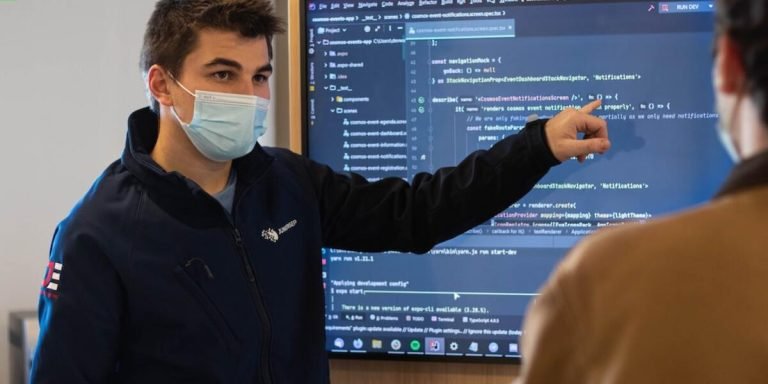Teacher PD: Exploring Effective Professional Development Strategies for Educators
The crucial role that “teacher pd” (professional development) plays in education cannot be overstated. Within the education industry, it refers to a planned program of professional learning designed to foster educators’ growth and enhance their teaching skills. But more than just individual educator improvement, teacher PD significantly impacts student success rates as well.
With all these benefits on the line, finding effective strategies for professional development becomes an imperative mission within every school’s ecosystem. From selecting appropriate courses and training programs suitable for today’s dynamic educational landscape to ensuring sustained support from parents and fellow educators—the journey can appear daunting but thoroughly rewarding when navigated optimally.
Did you know?
Despite being crucial for improving education outcomes, research suggests that less than 30% of teachers are highly satisfied with their professional development experiences – highlighting the need to explore more effective strategies.
The Role of Parental Engagement in Enhancing Teacher PD Initiatives
The role of parents in advancing teacher professional development (PD) is critical, particularly as technology continues to change our educational landscape. With the increasing need for technical proficiency and integration of technology tools into instructional strategies, parental involvement becomes crucial. This is because while it’s not every day that one hears about a parent contributing to their child’s educator PD endeavors, such contributions can indeed be impactful.
Parental engagement provides teachers with unique insights on children’s learning preferences at home which can inform their adoption or modification of certain technological tools during lessons. In turn, this contributes toward creating an effective tech-integrated classroom environment. After all, education doesn’t stop when the school bell rings – valuable teaching opportunities also exist outside traditional classrooms; at homes or even virtual platforms where parents play significant roles.
Furthermore, encouraging cooperative relationships between educators and families fosters shared understanding and commitment towards optimizing student success through beneficial use of technology in early childhood education settings. Parents’ feedback regarding what tech works well for their children could influence relevant training areas within Teacher PD initiatives focused on implementing newer technologies.
In conclusion: If synergized effectively by fostering open communication channels among all stakeholders involved – students included – Parental participation does boost Teacher PD efforts aimed at improving digital literacy skills acquisition amongst youngsters today- necessary toolkit needed for navigating life successfully amidst a rapidly digitizing world around us circa 2023!
Strategies for Integrating Family Contributions into Professional Development Programs
Parents hold valuable insights about their child’s learning needs, strengths, behavioural traits that can greatly serve as resources for educators during teacher PD sessions.
Incorporating parents’ involvement can be achieved through several strategies:
1) **Parent-Teacher Collaboration Workshops:** Organizing regular workshops where parents work alongside teachers allows opportunities for open communication and shared decision-making related to children’s learning progress.
2) **Community Meetings:** Scheduled community meetings encourage consistent interaction between families and schools’ staff members which help build strong school-community relationships needed for effective education of young learners.
3) **Online Platforms & Social Media Engagement**: As we’re living in 2023 digital platforms have become an indispensable part of our lives including academia. Utilization of online spaces provides fast-paced information sharing with large groups while enabling individual voices to be heard on topics like class activities updates or new teaching methods etc.
4) **Feedback Mechanisms**: Systems designed for allround feedback acceptances encourages dialogue between both parties hence acting as cornerstones enhancing efficacy in academic processes.
Examining the Impact of Parent-Teacher Partnerships on Educational Outcomes
In the ever-evolving realm of education, it’s become increasingly clear that parental engagement plays a crucial role in enhancing Teacher PD (Professional Development) initiatives. This symbiotic partnership provides teachers with unique insights and feedback from those who know their children best: the parents.
A strong parent-teacher alliance fundamentally shapes progressive teacher pd strategies. In fact, research suggests this collaboration can dramatically improve educational outcomes for students – let’s explore how.
Parents have an in-depth understanding of their child’s learning style and temperament which they share with educators during formal or casual meetings. This information is invaluable to help shape customized teaching approaches tailored specifically to each learner’s needs via tech tools such as adaptive software, e-books etc., thereby creating an optimized environment encouraging student success.
With direct input from parents on pupils’ strengths/weaknesses/preferences, professional development becomes more effective and personalized instructions plans more accurate . Teachers leveraging technology integration in education are equipped with better resources making them capable enough to build individual-centric lesson plans thus boosting academic achievements .
Innovative Approaches to Educator Support Through Collaborative PD Efforts
In the digital era of 2023, traditional approaches to professional development (PD) in education have evolved considerably. Innovative methods now take center stage and collaborative PD efforts are at the forefront of this evolution. As teachers’ roles expand from simply instructing students to facilitating their learning journey, support mechanisms need a parallel upgrade as well; they must move beyond basic training workshops or individual studies.
One such promising trend is technology integration in education – weaving tech tools effectively into pedagogical practices for better outcomes. This approach speaks directly to educators’ needs today: it presents opportunities for continuous skill improvement while helping them adapt instruction techniques that foster active engagement among digitally-native learners.
Taking advantage more increasingly sophisticated platforms enables tailor-made teacher PD programs aimed at shared knowledge-building rather than isolated teaching exercises. Teachers can collectively participate in webinars, online conferences or social media groups formulated exclusively around classroom technologies – building not just functional aptitude but also important communication skills essential in managing connected classrooms.
Collaborative environments provide an avenue where novice teachers sharpen their skills alongside seasoned professionals sharing first-hand experiences and best practice strategies about successful technology use within learning contexts – ultimately strengthening collective efficacy on an institutional level which contributes decidedly towards student success.
Tailoring In-Service Training to Address Classroom Challenges with Parent Insights
As the education industry evolves, the emphasis on teacher professional development (PD) has gained a notable spotlight. The traditional model of ‘in-service’ or continuing education for teachers is being transformed to meet modern demands and challenges in classrooms. A significant part of this transformation involves integrating parent insights into these training programs.
Gone are days when parental involvement was limited to homework assistance and PTA meetings; now they play an active role in shaping their children’s educational experiences through collaborations with educators – thanks largely to technological advancements enhancing communication avenues.
One innovative approach is tailoring in-service training based not just on theoretical knowledge but also incorporating real scenarios faced by teachers and brought forward by parents via various tech platforms. This ensures that PD sessions address practical issues encountered daily rather than abstract pedagogical concepts alone.
A great example can be seen where school districts utilize online forums as platforms for dialogue between parents, teachers, administrators before organizing PD workshops or seminars—that way course content becomes more specific addressing individual classroom needs—thanks again to technology integration!
Moreover, considering parental input allows us educators make meaningful improvements aiming directly at students’ growth points which arguably should be ultimate goal any teaching-training endeavor! By bridging gap between school-home environments through tailored PD measures we inevitably contribute positively towards children’s academic outcomes helping them excel even further 21st century skills quest while conveniently ticking off our “teacher pd” goals.
Leveraging Community Resources for Comprehensive Teacher Continuing Education
In the ever-evolving landscape of education, sparking novel professional development (PD) strategies for educators is more important than ever. One such innovative approach involves harnessing community resources to provide teachers with extensive and comprehensive continuing education opportunities.
One critical aspect here is leveraging local businesses in teacher PD initiatives. Businesses often have a vested interest in producing competent future employees skilled in their respective industries—be it technology, manufacturing or healthcare. These enterprises can offer workshops or training programs tailored specifically towards teaching staff that not only enhance industry-specific knowledge but also allow teachers to impart real-world experiences into classroom teachings.
Another avenue open for exploration is collaborating with non-profit organizations. Many non-profits operate programs targeting childhood education enhancement which could be pivotal assets when integrating new learning methodologies based on technological advancements inside classrooms. Teachers taking part would gain fresh perspectives about how different tools can promote better student engagement – all while enhancing their personal skillset fortifying academic success potential.
Public libraries too present enormous possibilities serving as hubs for teacher continuing education efforts due to their role as centers of lifelong learning – housing vast information sources beyond books alone like digital literacy courses or tech tool orientations beneficial to both students and teachers alike!
Local colleges & universities represent potent allies too offering post-graduate degree options, certificate programs alongwith access to research databases imperative for staying updated on current pedagogical trends especially revolving around Technology Integration happening at breakneck speeds across globe’s educational spectrum.
Measuring the Effectiveness of Teacher PD Through Student and Parent Feedback Loops
As we continue to embrace the digital age, teacher professional development (PD) plays an increasingly pivotal role in enhancing educational outcomes. One decisive way of gauging the effectiveness of PD sessions is through feedback loops from students and parents – important stakeholders in a child’s learning journey.
Effectiveness isn’t just about knowing how to use technology; it’s also about understanding when and why to utilize these tools for maximum impact on pupil comprehension. Schools are investing substantially in training teachers with ‘teacher pd’ programs so they can masterfully integrate technology into curriculums, aiming at both accessibility and engagement concerns.
Parents provide an integral link between children’s school experiences and home environments. Therefore their insights form valuable metrics while evaluating teaching proficiency post-teacher PD sessions: Is homework more interactive? Are online classes engaging or exhausting?
This multisource feedback approach adds nuance to our perceptions around improved classroom instructions utilizing tech aids.
Students themselves often offer unmatched first-hand narratives regarding changing patterns pre-and-post educator upskilling initiatives concerning technological incorporation within lessons. They’re uniquely positioned to assess whether there has been any noticeable amelioration resulting from such movements – are classes now more fun-filled yet focused due?
Drawing upon parent-student reviews assists not only efficacy determination but also propels tailored modifications befitting individual schooling cultures demystifying ‘one size fits all’ approaches towards optimized childhood education models globally thriving amidst 2023 realities!
Implementing Constructive Communication Channels Between Families and Schools
Establishing effective communication channels between families and schools forms a critical part of teacher professional development (PD). This symbiotic relationship is pivotal to measure the impact and refine teaching methodologies. Technology has facilitated this interaction, ensuring it’s possible even in remote learning scenarios that 2023 brought into limelight.
Implementing constructive communication practices give parents an insight into their child’s educational journey. Virtual conferences, emails, text messages are some tools teachers could employ for regular updates about children’s progress. Proper execution of these methods keeps parents informed but also offers educators vital feedback improving teacher PD processes further.
Parent-teacher collaboration holds potential benefits such as enhanced student achievement and improved behavior at school – achievable when there’s open dialogue maintained through technology-enabled platforms.
Feedback loops play a significant role too; they are data-driven evidence collected via surveys or digital discussion forums measuring teacher PD success indirectly by assessing students’ understanding levels over time based on parental observation at home. These insights help educators reassess their strategies making necessary improvements where needed bolstering overall effectiveness of Teacher PDs.
In essence, integrating technology within parental support systems provides multiple avenues facilitating ongoing conversations aiding both parties involved: Parents become more engaged with their ward’s education while teachers gain invaluable perspectives fine-tuning their techniques aligning better with the ever-evolving classroom dynamics.
Utilizing Surveys and Interviews to Inform Future Professional Development Plans
In today’s digital era, technology integration in education is a crucial aspect of our children’s learning experience. As part of the efforts in this area, teacher professional development or “teacher pd” often plays an important role. Understanding how effective these programs are can be measured through various methods; one particularly useful method includes utilizing surveys and interviews to inform future professional development plans.
Digital surveys offer us invaluable insights into how successful specific tech-integrated teaching strategies have been implemented within classrooms. These electronic questionnaires allow parents and students alike to provide direct feedback about their experiences with new techniques introduced by teachers after attending training sessions.
Since they’re anonymous online platforms, respondents feel more confident openly sharing both positive evaluations and constructive criticism without fear of reprisal from the educators themselves – leading to honest evaluation data that will help shape upcoming PD agendas based on real-world classroom needs.
Complementing survey responses are structured face-to-face interviews with selected participants – whether students or parents – who are willing share deeper insights regarding any perceptible shifts seen post-technology integrated teacher pd sessions’. Interviews give nuanced viewpoints about what does (or doesn’t) work well when tech gets incorporated into lessons following advanced training opportunities offered via PD schemes’.
Conclusion
In the field of education, Teacher PD isn’t a flashy buzzword—it’s an essential ingredient to nurturing competent educators and outstanding learners. Remember that effective professional development strategies are not stagnant; they evolve with each educational breakthrough, offering innovative ways to enrich teaching skills. Keep yourself abreast of these changes in order to provide the highest level quality learning experience for your students.
Don’t stop at this article – our website holds a treasury of resources aimed at empowering parents and educators alike in their noble task – educating children. Immerse yourselves into more insightful information backed by research on childhood education or literally anything you need when it comes down to supporting teachers along every step of their challenging but rewarding journey.







